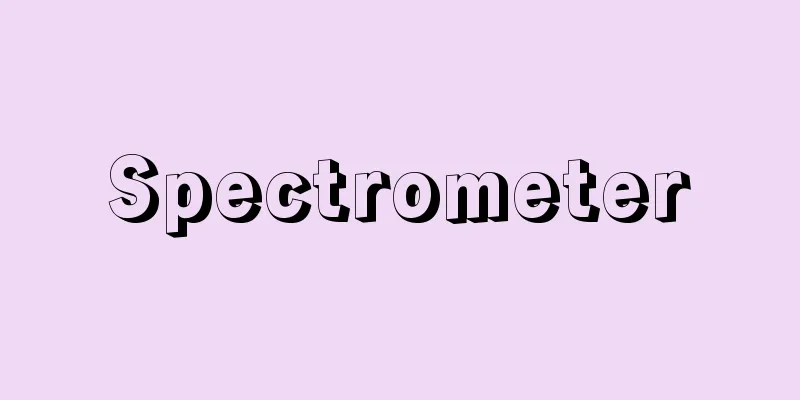Cognition - Ninchi (English spelling) cognition

|
Cognition is a word used to refer to the mental activity of recognizing and understanding something, to refer to the result of that, or to refer to the ability, structure, or mechanism that makes such recognition possible. It is synonymous with cognition, and the term cognition is often used in psychology-related fields, but in information engineering and AI (artificial intelligence), the term cognition is also often used. In Japanese, it is called "cognition," but there are many cases where the term cognition is not used in English. For example, the term recognition is used in cases such as pattern recognition (recognition) and voice recognition, and the term perception is used in cases such as risk recognition and interpersonal recognition. The workings of the human mind have long been classified into three categories: knowledge, emotion, and will. Knowledge is knowing something and refers to perception, recognition, and understanding, emotion is feeling something and refers to emotions and feelings, and will is trying to do something and represents intention and will. In this classification, cognition corresponds to knowledge. [Cognition and other psychological functions] However, in reality, these three are deeply interconnected, and in many cases cognition is not performed independently of emotion or will. It is well known that the level of attention, memory, and thinking change depending on the emotional state. It is also well known that motivation to do something and what creates motivation strongly influence learning. The reverse is also true, and it goes without saying that emotions and motivation change as a result of cognition. In psychology, a distinction has been made between sensation, perception, and cognition. In general, sensation is used to detect stimuli received by a specific sensory organ and to grasp their intensity (for example, "red" or "hot"). Perception is used when it is not only the detection of a specific sensation, but also includes the overall understanding of the object that gives that sensation (for example, the object in front of one's eyes is "round, red, and shiny"). Cognition often refers to the activity of further linking the perceived content with other related information (for example, regarding a "round, red, shiny object" in front of one's eyes as a "red traffic light"). In general, there is a tendency to use sensation, perception, and cognition depending on the complexity of the content to be recognized. However, this division is also vague, and it is not possible to clearly draw the line between perception and cognition. [Cognition in the history of psychology] Cognition in the history of psychology, and from the perspective of psychology history, the term cognition is used in contrast to behaviorism and can also represent a certain research position or stance. In behaviorism, the main goal has been to identify the functional relationship between stimuli and responses based on reinforcement. In contrast to this position, the word cognition has been used to refer to behavior that does not require reinforcement and to internal states of the organism that are unrelated to reward. Examples include cognitive maps, cognitive dissonance, and cognitive styles. On the other hand, in cognitive psychology, which has developed rapidly since the 1970s, inspired by ideas from information science, the use of the term cognition is a little more limited. There, the focus is on what is happening between stimuli (input) and responses (output). In other words, cognitive research explores what kind of internal processing (calculation) is performed on input information, what kind of output (representation) is produced as a result, and what structure makes this internal processing possible. When the word cognition is used in this context, it includes not only categorization and reasoning, but also goal generation, planning, decision-making, and monitoring of the execution process. [Cognition and Consciousness] The word "cognition" usually means to grasp something consciously, and it is believed that in many cases, things that are recognized can be described in language. It is also generally believed that the process of cognition at a certain level or higher, such as learning and thinking, can be verbalized and consciously controlled. However, cognition can also occur without the involvement of consciousness or language. In implicit memory research using priming, the performance of a subsequent task changes depending on previous experience, but the subject is not aware of this. The same effect can also be obtained by presenting a stimulus at a level that the subject cannot be aware of (subliminal stimulus) in the previous task. This shows that a certain cognitive state occurs even without being made conscious, and that it affects behavior. Cognition is independent of verbalization. Skilled behaviors often cannot be verbalized, and the process of controlling the behavior cannot be made conscious. For example, when walking, it is necessary to instantly recognize and control the movement of the center of gravity, its speed, the bending of each joint, and the timing between them, but humans can hardly say anything about these processes. In general, the cognition involved in skilled behavior cannot be verbalized in most cases. We also believe that we can consciously control our actions and judgments, but this is not necessarily the case. Even if we know that an optical illusion is an illusion, the illusion does not go away. Also, as with incidental learning, we can remember things to a large extent even without the conscious effort to remember them. Furthermore, it is known that people's introspection of their thought and judgment processes often does not match the facts. In this way, cognition is to a large extent independent of consciousness and language. [Evolution of cognition, development of cognition] Cognition is made possible by innate mechanisms and knowledge acquired from experience. In this case, it does not mean that no input from the environment is necessary or that cognition is possible immediately after birth. For humans who grow up in a normal environment, if it is expressed semi-automatically by information from the environment that they are almost certain to encounter, it can be said to be innate. From this, the existence of working memory and long-term memory and the connections between them, the form of knowledge storage and activation, and the structures that realize cognitive functions such as three-dimensional perception, imitation, language comprehension and speech have also been formed through evolution, and are considered to be innate in the sense that they exist universally in the human species. On the other hand, not only humans but all living things accumulate various experiences immediately after birth, store some of them inside the cognitive mechanism, and reuse them when necessary. This enables them to perform more adaptive behavior. In the case of humans, what is stored internally is generally called knowledge, which can be divided into types such as episodes, concepts, and procedures. [Cognition and Culture] Because human cognition is also influenced by experience, it becomes necessary to consider the relationship between cognition and culture. This is because culture is a device that controls the experiences of the people who belong to it. Although there is no one-to-one correspondence, it is not uncommon for a particular language to be used within a certain culture. There are many words that exist in one language but not in another. Because words represent concepts, it is possible that the way the world is perceived differs between different languages. The Sapir-Whorf hypothesis was the first to point out this possibility. In reality, the relationship between language and cognition is complex, and there are views that both support and reject this hypothesis. On the other hand, some research points out cultural differences that go beyond language. For example, it has long been pointed out that the Western way of looking at things is different from the Eastern way of looking at things. In recent years, more rigorous research has been conducted to support this intuition, reporting that while the Western world is characterized by analytical and focused cognition and experimentation, the Eastern world is characterized by comprehensive and integrated cognition and thinking. In addition, public education is available in all societies that have modernized to a certain degree. It is known that this type of education also changes cognition. In general, those who receive public education are less dependent on concrete contextual information and are capable of formal and abstract thinking. However, ignoring contextual information is not necessarily appropriate. In this sense, it has been pointed out that what school culture cultivates is school-like intelligence. Humans have developed culture by making good use of the tool known as language. Communicating with other humans, receiving an education, and reading books are all unthinkable without the existence of language. Cultures that use language have made it possible for people to efficiently incorporate the experiences of others into their own. It has been pointed out that this has allowed humans to develop in a way that is different from other living things, in an extremely short period of time, evolutionarily speaking. Humans have also used various tools and accumulated them as culture. Tools substitute for some of the intellectual work that humans perform, so by using them well, the efficiency, productivity, and creativity of intellectual work can be increased. In recent years, in addition to tools such as paper and pencils, research has been conducted to understand cognition in relation to computers, the Internet, and situations in general that include these, and this research has been developed as situated cognition or distributed cognition. In other words, the idea is that cognition is not only within the individual, but is embedded in the environment and relationships with others. [Comparative research on cognition] Comparative research on cognition has revealed that many of the functions that make up human cognition, such as memory, attention, selection, and reasoning, are basically also found in animals. Of course, there are also cognitive abilities that humans excel in, one of which is social cognition. Sensitivity to the emotions of others is extremely important in living a social life, and empathy is a basic function of this. Empathy is the sharing of the emotions of others with one's own emotions, and it is not just the recognition of the emotions of others, but also the matching of one's emotions with those of others. Therefore, empathy can be thought of as a link between other-cognition and self-cognition. The relationship between the state of others and the state of oneself can be divided into four types. The basic situation is that the discomfort of others becomes one's discomfort, which is "negative empathy." This corresponds to sympathy. Conversely, when the pleasure of others becomes one's pleasure, this is "positive empathy." However, it is also possible for the pleasure of others to be felt as discomfort (such as in the case of jealousy), which is known as reverse empathy. Furthermore, when the discomfort of others is felt as pleasure (in Japanese, "other people's misfortune is sweet"), the German word Schadenfreude is commonly used. Negative empathy, in which the misfortune of others is aversive, is recognized in many species. The expression of discomfort by others often serves as a danger signal for the self, and the aversive nature of this has a function of crisis avoidance. When the self and others receive the same reinforcement, positive empathy can be considered social facilitation, as seen in feeding behavior, but it is questionable whether observing an individual in a pleasurable state generally has a reinforcing effect on animals. Reverse empathy is considered to be an irrational behavior that has no direct benefits, but it is thought to form the basis of fairness in a sustainable society. Watanabe, S. (2011) obtained results showing positive empathy and negative empathy using mice. It is not possible to expect something as standardized as the fairness of human society in animal society, but reverse empathy may be one of its precursors. There is no direct benefit to Schadenfreude either, and it is difficult to recognize it in animals other than humans. The essential feature of human Schadenfreude is the concealment of pleasure. Openly expressing pleasure in the misfortune of others is inappropriate for maintaining a society, while concealing such hostile emotions appears to be necessary behavior for maintaining a long-term sustainable society. [Self-recognition in animals] Self-cognition in animals is often examined based on whether or not they can recognize their own image in a mirror. When chimpanzees see a mirror for the first time, they show social behavior toward other individuals, such as threatening or greeting the image in the mirror. However, these social behaviors soon disappear, and they start to show self-directed behavior, such as investigating parts of their own body that cannot be seen directly. A similar phenomenon is seen in humans, such as small children and congenitally blind people who have undergone eye opening surgery. For these reasons, it is believed that the experience of looking in a mirror is essential for recognizing the image in the mirror as themselves. Gallap, GG (1970) devised the mark test to experimentally examine chimpanzees' self-recognition of the mirror image. The mark test is a method in which a mark is placed on a place that the animal cannot see directly, such as the forehead, without the animal's notice, and then when the animal is later shown a mirror, it is examined whether self-directed behavior, such as touching the mark, appears. In this mark test, apes such as humans, bonobos, chimpanzees, and orangutans are able to touch the mark, whereas most non-ape primates do not lose their social behavior and do not show self-directed behavior even when they have the opportunity to touch the mirror for a fairly long period of time. It has been reported that non-primate mammals such as bottlenose dolphins, killer whales, and Asian elephants, as well as birds such as magpies, show self-directed behavior toward their own mirror image. In addition, results suggesting self-recognition have been reported in invertebrates such as squids. Therefore, it is thought that the recognition of mirror self-image is a cognitive ability that arose independently during the evolution of several species, regardless of their biological affinity with humans. However, there are two interpretations of self-directed behavior in the mark test: one that sees it as a reflection of self-consciousness and the basis of the theory of mind, and the other that sees it as the ability to match the visual information of one's own image reflected in the mirror with one's own motor senses. Toda, K. et al. (2008) used a video slow-play device and found that pigeons were able to match their own motor sense with the video for up to about three seconds. For a long time, animal self-recognition was limited to the paradigm of mirror self-recognition. However, in the mid-1990s, the field of research expanded dramatically with the devising of methods to examine episodic memory and metacognition using non-verbal procedures. [Metacognition] Metacognition is a general term for monitoring cognitive processes such as the presence or absence of one's own knowledge, the accuracy of memory, and confidence, and adjusting behavior according to goals. Monitoring of memory is also called metamemory. A method for studying metacognition in animals was devised by Smith, JD et al. (1995). They trained bottlenose dolphins to discriminate whether a stimulus sound had the same or lower frequency as a reference sound. In the test, in addition to answer options, an avoidance option was given. If the avoidance option was chosen, the main task was replaced with a task that was easier to discriminate, making it easier to obtain a reward. On the other hand, if the avoidance was used frequently, a penalty was given that it took longer to replace the task. Bottlenose dolphins avoided more frequently as the stimulus sound approached the reference sound, and this tendency was consistent with that of humans performing the same task. From these results, it is thought that dolphins, like humans, avoided using the lack of confidence as a cue. Since this study, metacognition in animals has been examined by adding secondary tasks that involve avoidance choices before, during, and after the main task, such as perceptual discrimination and memory recognition, and examining the correlation between the difficulty of the main task, performance, and the choice of the secondary task. In addition to avoidance choices, the behavior of seeking additional information (hints) when a task is difficult is also considered to be metacognition. Apart from the bottlenose dolphins mentioned above, primates have been reported to display metacognitive behavior in various tasks, but since there are few research reports on other animals, it is not clear which animals have what kind of metacognition. However, it has been reported that in birds such as pigeons, chickens, and crows, the judgement of confidence after completing a task correlates with the correctness of the answer, so it is thought that metacognition is not limited to primates. For a long time, research on self-consciousness and introspective processes in animals was limited to mirror self-recognition, but metacognition research is significant in that it defines these from different aspects in a verifiable way. →Consciousness →Sensation →Emotion →Memory →Social learning →Perception →Knowledge →Cognitive psychology →Discrimination learning →Metacognition [Hiroaki Suzuki], [Shigeru Watanabe, Kazuhiro Goto] Latest Sources Psychology Encyclopedia Latest Psychology Encyclopedia About Information |
|
認知とは,何かを認識・理解する心の働きを指す場合,その結果を指す場合,あるいはそうした認識を可能にする能力,構造,機構を指す場合などに用いられる語。認識cognitionと同義で,心理学関連の分野では認知という用語がよく用いられるが,情報工学やAI(人工知能)などでは認識という用語もよく用いられる。日本語では「認知」とされるが,英語でcognitionという用語が使われていないケースも少なくない。たとえば,パターン認知(認識)や音声認識などの場合には,recognitionという用語が使われるし,リスク認知,対人認知の場合のようにperceptionという用語が使われたりもする。 人間の心の働きは,早くから知情意という3分類がなされてきた。知は何かを知ることであり知覚,認識,理解などを指し,情は何かを感じることであり感情や情動を指し,意は何かを行なおうとすることであり意図や意志を表わしている。認知とはこの分類でいえば知に該当する。 【認知と他の心理機能】 ただし,実際にはこの三つは相互に深いつながりをもっており,多くの場合認知が情や意と独立に行なわれているわけではない。感情の状態によって注意の度合いや,記憶や,思考の仕方が変化することはよく知られている。また何かを行なおうとする動機や,動機が何によって生み出されるのかが,学習に強く影響することもよく知られた事実である。その逆もまた真であり,認知の結果,感情や動機づけが変化することはいうまでもない。 心理学の中では,感覚,知覚,認知という区別が行なわれてきた。一般に感覚sensationとは,特定の感覚器が受け取る刺激の察知やその強度の把握に用いられる(たとえば「赤い」,「熱い」など)。知覚perceptionは特定の感覚の察知だけではなく,その感覚を与える対象の全体的な把握を含む場合に用いられる(眼前の対象が「丸くて赤くて光っている」など)。認知はさらに知覚内容を関連する他の情報と結びつける活動を含む場合を指すことが多い(眼前の「丸くて赤くて光っている」ものを「赤信号だ」とすることなど)。一般に認識する内容の複雑さに応じて,感覚,知覚,認知を使い分ける傾向がある。ただしこの区分も曖昧であり,どこまでが知覚であり,どこから先は認知であるという明確な線引きができるわけではない。 【心理学史の中の認知】 心理学史の中の認知,さらに心理学史の観点からすれば,認知という用語は行動主義behaviorismと対比的に使われ,ある研究の立場,スタンスを表わすこともある。行動主義では主に強化に基づく刺激と反応との間の関数関係を特定することが目的とされてきた。こうした立場とは異なり,強化を要しない行動,報酬とは無関係な生体の内的状態に言及する際に認知ということばは使われていた。たとえば認知地図,認知的不協和,認知スタイルなどの用語が挙げられる。一方,情報科学の考えに触発されて,1970年代あたりから急速に発展した認知心理学cognitive psychologyにおいては,認知という用語の使われ方がもう少し限定的となる。そこでは,刺激(入力)と反応(出力)の間で何が行なわれているかに焦点が当てられる。つまり,入力情報にどのような内部処理(計算)が行なわれるのか,その結果どのような出力(表象)が生み出されるのか,またその内部処理はどんな構造によって可能になるのかを探究するのが認知研究となる。このような文脈で認知ということばが用いられる場合には,カテゴリー化,推論などはもちろん,そこからの目標の生成,プランニング,意思決定,実行過程のモニタリングまでもが含まれる。 【認知と意識】 認知ということばは通常,対象を意識的に把握するという意味合いをもち,認知された事柄は多くの場合,言語的に記述可能であると思われている。また学習や思考などの一定以上高次の認知は,そのプロセスについても言語化や意識的なコントロールが可能であるかのように一般には考えられている。しかしながら,認知は意識consciousnessや言語languageが関与しない場合にも成立している。プライミングを用いた潜在記憶研究では,事前に経験したことによって後続の課題の成績が変化するが,このことに被験者が気づくことはない。また事前の課題において被験者が意識できないレベルの刺激(サブリミナル刺激subliminal stimulus)を提示することによっても同様の効果を得ることができる。このことは意識化されなくてもある種の認知状態が生起しており,それによって行動に影響が出ることを示している。認知は言語化とも独立である。熟練した行動は多くの場合言語化することはできないし,その行動をコントロールする過程を意識することもできない。たとえば歩行に関しては,重心の移動,そのスピード,各関節の曲がり具合,およびそれらの間のタイミングなどを瞬時に認知して制御する必要があるが,こうした過程について人間はほとんど何も語ることはできない。一般に熟練した行動にかかわる認知はほとんどの場合言語化できない。 またわれわれは,行動や判断を意識的にコントロールできると思っているが,必ずしもそうではない。錯視図形はそれが錯視であることを知っていても,錯視がなくなるわけではない。また偶発学習のように記憶しようという意識がなくても,かなりの程度の記憶がなされてしまう。さらに人の思考や判断の過程についての内省は,事実と一致しないことが多いことも知られている。このように認知は,意識や言語とはかなりの程度独立したものである。 【認知の進化,認知の発達】 認知は生得的な機構と経験から獲得された知識とによって可能になる。この場合,環境からの働きかけが一切必要ないとか,出生直後からその認知が可能ということを意味するわけではない。通常の環境で育つ人間であれば,ほぼ確実に出会う環境からの情報により半ば自動的に発現するのであれば,それは生得的といえるだろう。こうしたことからすれば作業記憶や長期記憶の存在やその間のつながり,知識の貯蔵の形式や活性化のされ方,3次元の知覚,模倣,言語理解や発話などの認知機能を実現する構造も進化的に形成されてきたものであり,人間という種に普遍的に存在しているという意味で生得的と考えられる。一方,人間に限らず生物一般は生後直後からさまざまな経験を重ね,それらの一部を認知機構の内部に貯蔵し,必要な場面でそれを再利用する。これによってより適合的な行動を行なうことが可能になる。人間の場合,内部に貯蔵されたものは一般に知識knowledgeとよばれるが,それはエピソード,概念,手続きなどのタイプに分かれる。 【認知と文化】 人間の認知は経験によっても影響されるということから,認知と文化cultureの関係を考える必要が出てくる。文化とはそこに所属する人間の経験のあり方をコントロールする装置だからである。一対一の対応はないが,ある文化内ではある特定の言語が用いられることが少なくない。ある言語には存在するが別の言語には存在しない単語は数多い。単語は概念を表わすわけだから,異なる言語の間では世界の認知のされ方が異なる可能性がある。サピア-ウォーフの仮説Sapir-Whorf hypothesisは,こうした可能性を最初に指摘したものである。実際には言語と認知の関係は複雑であり,この仮説を肯定する見解と否定する見解がある。 一方,言語を超えた文化差を指摘する研究もある。たとえば,西洋的なものの見方と東洋的なものの見方は異なるという指摘は以前からよくなされてきた。近年はこれらの直感を裏づける,より厳密な研究が行なわれ,西洋は分析的で焦点化された認知や試行が行なわれている一方,東洋は包括的で総合的な認知や思考が行なわれているという報告がなされている。また,一定以上近代化した社会ではどこでも公教育が行なわれている。こうした教育によっても認知は変化することが知られている。一般に公教育を受けた場合には,具体的な文脈情報に依存する度合いが低くなり,形式的・抽象的な思考が可能になる。しかし,文脈情報を無視することは,必ずしも妥当とはいえない。こうした意味で学校文化が育てるのは,学校的な知性であるという指摘がある。 人間は言語という道具をうまく活用することで文化を発達させた。人間と対話すること,教育を受けること,書物を読むこと,これらはすべて言語の存在を抜きにしては考えられない。言語を利用した文化によって,他者の経験を自分の中に効率的に取り込むことが可能になった。こうしたことにより,進化的に見ればきわめて短い時間で,人間が他の生物とは異なる発展を遂げたとする指摘がある。 また人間はさまざまな道具toolを利用して,それを文化として蓄積してきた。道具は人間の行なう知的作業の一部を代行するものであるので,これをうまく利用することで知的作業の効率,生産性,創造性が高まる。近年は,紙や鉛筆などの道具に加えて,コンピュータや,インターネット,あるいはそれらを含む状況一般との関係で認知をとらえようとする研究が進められ,状況的認知situated cognition,あるいは分散認知distributed cognitionの研究として展開している。すなわち認知は個人の中にのみあるのではなく,環境や他者とのかかわりの中に埋め込まれているとする考え方である。【認知の比較研究】 認知の比較研究はヒトの認知を構成する記憶,注意,選択,推論など多くの機能が基本的には動物でも認められることを明らかにしてきた。もちろんヒトにおいて傑出している認知能力もあり,その一つは社会的認知である。社会生活を営む上で他者の情動に関する感受性はきわめて重要であり,共感はその基本的な機能である。共感empathyは他者の情動を自分の情動と共有することであり,他者の情動の認知であるにとどまらず自己と他者の情動とのマッチングである。したがって,共感は他個体認知と自己認知をつなぐものと考えることができる。 他者の状態と自己の状態の関係は4通りに分けることができる。他者の不快が自分の不快になることが基本であり,これが「負の共感」である。同情がこれに当たる。逆に他者の快が自己の快になるのが「正の共感」である。しかし,他者の快が不快に感じられること(いわゆる嫉妬など)も考えられ,逆共感といわれる。さらに他者の不快を快とする場合(日本語での「他人の不幸は蜜の味」)は,ドイツ語のSchadenfreude(シャーデンフロイデ)が慣用的に用いられている。 他者の不幸が嫌悪性をもつ負の共感は多くの種で認められている。他者の不快の表出はしばしば自己にとっても危険の信号となり,これが嫌悪性をもつことは危機回避としての機能をもつ。他者と自己が同じ強化を得ている場合には,正の共感は社会的促進として考えられ,これは摂食行動などで認められるが,快状態にある個体を観察することが動物にとって一般的に強化効果をもつかどうかは疑問の余地がある。逆共感はそれによる直接的な利点はなく非合理的な行動だと考えられるが,持続的な社会においては公平性の基礎をなすものだと考えられる。Watanabe,S.(2011)はマウスを用いて正の共感,負の共感を示す結果を得ている。人間社会の公平性のような規範化されたものを動物社会で求めることはできないが,逆共感はその前駆となるものの一つだろう。Schadenfreudeにおいても直接的な利点はなく,ヒト以外の動物では認めにくい。ヒトのSchadenfreudeの本質的な特徴は快感を秘匿するところにある。他者の不幸が快感であることのあからさまな表明は社会の維持には不適切であり,このような敵対的な情動の秘匿は長期持続的な社会の維持に必要な行動であると思われる。 【動物の自己認知】 動物の自己認知self cognitionは,鏡に映る自己像を自分であると理解できるかどうかによって検討されることが多い。チンパンジーは初めて鏡を見たとき,鏡映像に対して威嚇やあいさつなど,他個体に対する社会的行動を示す。しかし,すぐにこれらの社会的行動は消失し,自分の体のうち直接見られない部位を調べるなどの自己指向的行動を示すようになる。同様のことは,ヒトでも小さな子どもや先天盲で開眼手術を受けた人などで見られる。これらのことから,鏡映像を自分であると認識するためには,鏡を見るという経験が不可欠であると考えられている。ギャラップGallap,G.G.(1970)は,チンパンジーの鏡映像に対する自己認知を実験的に検討するために,マークテストmark testを考案した。マークテストとは,動物に気づかれないように,額など直接自分では見えない場所にマークを付け,後で鏡を見せたときに,マークに触れるなどの自己指向的行動が出現するかを検討する方法である。このマークテストでは,ヒト,ボノボ,チンパンジー,オランウータンなどの類人猿がマークを触れるようになるのに対して,類人猿以外の霊長類の多くは,かなり長い期間,鏡に触れる機会があっても,社会的行動が消失せず,自己指向行動が見られない。霊長類以外の哺乳類では,ハンドウイルカ,シャチ,アジアゾウが,鳥類ではカササギが自己鏡映像に対する自己指向的行動を示すことが報告されている。また,無脊椎動物ではイカで自己認知を示唆する結果が報告されている。したがって,鏡像自己認知recognition of mirror self-imageはヒトとの生物学的類縁とは関係なく,いくつかの種の進化の過程で独立に生じた認知能力だと考えられる。ただ,マークテストでの自己指向的行動の解釈には,これを自己意識の反映で,心の理論の基盤となるものだとする立場と,鏡に映る自分の姿の視覚情報と自分の運動感覚との見本合わせ能力とする立場がある。Toda,K.ら(2008)はビデオの遅進再生装置を用いて,ハトが自分の運動感覚とその動画とのマッチングが3秒程度まで可能であることを得た。 動物の自己認知は,長い間,鏡映像自己認知というパラダイムに限定されていたが,1990年代半ばに,非言語手続きによってエピソード記憶やメタ認知を検討する手法が考案されたことで,飛躍的に研究分野が拡大した。 【メタ認知metacognition】 自分自身の知識の有無,記憶の確かさ,確信度などの認知過程をモニタリングすること,および目標に応じて行動を調整することを総称してメタ認知という。記憶に関するモニタリングをとくにメタ記憶ともいう。動物におけるメタ認知を研究する手法は,スミスSmith,J.D.ら(1995)によって考案された。彼らは,ハンドウイルカに,ある基準音と比べて刺激音の周波数が同じか低いかを弁別するように訓練した。テストでは,回答選択肢に加え,回避選択肢が与えられた。回避選択肢を選ぶと主課題は弁別が容易な課題と置き換えられ,報酬が得やすくなった。一方,回避を多用すると,課題置き換えにより長い時間がかかるペナルティが与えられた。ハンドウイルカは,刺激音が基準音に近づくにつれ,より高頻度で回避し,この傾向は,同じ課題遂行中のヒトのそれと一致していた。この結果から,イルカがヒトと同様に,確信のなさを手がかりに回避していたと考えられる。この研究以降,動物のメタ認知は,知覚弁別や記憶再認などの主課題とは別に,それの遂行前,遂行中,および遂行後の回避選択による副課題を付加し,主課題の難易度や成績と副課題の選択の相関を調べることで検討されている。また,回避選択以外にも,課題が難しい時に,追加情報(ヒント)を希求する行動もメタ認知であると考えられている。 上述のハンドウイルカ以外では,霊長類がさまざまな課題でメタ認知的行動を示すことが報告されているが,他の動物では研究報告数自体が少ないため,どの動物にどのようなメタ認知があるのかは明らかになっていない。しかし,ハト,ニワトリ,カラスなどの鳥類において,課題遂行後の確信あり,なし判断が回答正誤と相関することを示すことが報告されるなど,メタ認知は霊長類に限定されるものではないと考えられている。動物では,自己意識や内省的過程に関する研究は長い間,鏡映像自己認知に限定されていたが,メタ認知研究はこれらを別の側面から検証可能な形で定義した点で大きな意義がある。 →意識 →感覚 →感情 →記憶 →社会的学習 →知覚 →知識 →認知心理学 →弁別学習 →メタ認知 〔鈴木 宏昭〕・〔渡辺 茂・後藤 和宏〕 出典 最新 心理学事典最新 心理学事典について 情報 |
>>: Labor Camp - Ninsokuyoseba
Recommend
Ligase - ligase
A general term for enzymes that catalyze the reac...
Planning Assistance Through Technical Evaluation of Relevance Numbers
...It is also a method to analyze whether the goa...
Kallas, A. (English spelling) KallasA
…Among female writers, Talvio is a gifted writer,...
Astilbe thunbergii (English spelling) Astilbethunbergii
… [Munemin Yanagi]. … From [Awamori Shouma (Awamo...
Harada's disease
…Behçet's disease and sarcoidosis are designa...
Oedipus in Egypt
… One of Kircher's most ambitious attempts wa...
Saburo Shimada
A journalist and politician during the Meiji and ...
Dionysio-Hadriana (English spelling)
… [middle ages] During the Carolingian dynasty, c...
Polar Compounds - Polar Carbide
A compound with polarity within the molecule. Not...
Dermatocarpon myogiense (English spelling)
… [Hiroyuki Kashiwatani]. … *Some of the terminol...
Arnold, Gottfried
[Birth] 1666 [Died] 1714 German theologian. Influe...
Grader - Grader (English spelling)
A construction machine used for leveling airfield...
Kamares Pottery - Kamaresutouki
A type of pottery produced in Crete during the Br...
"The Chronicle of Gyoki"
...The common people who gathered to admire him o...
Cagnard de la Tour, C.
…When one of the disks is rotated, air is release...









